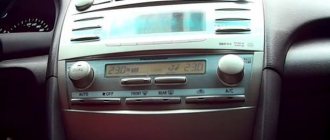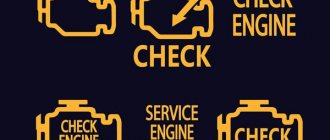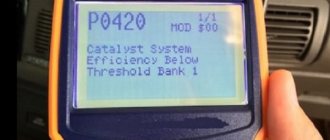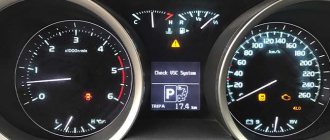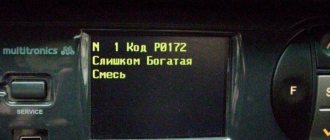P0420 - error code "low catalyst efficiency"
Trouble code P0420 stands for: "catalytic converter system efficiency below threshold." This indicates a very weak catalyst throughput. If the car is equipped with two neutralizers at once, then this error may also have code P0430. In the English version, the description of the malfunction will sound like Catalyst System Efficiency Below Threshold (Bank 1) or (Bank 2). It is not difficult to guess that the problem will most likely indicate the end of the catalyst’s service life, although there is hope that it is bad fuel or the second lambda has failed.
What does P0420 mean?
The P0420 code indicates that there is a problem with the catalytic converter. The catalytic converter is designed to break down harmful pollutants produced during the combustion cycle of a gasoline engine. By using fine platinum and gold meshes to filter exhaust gases, the catalytic converter is able to reduce emissions of harmful substances from the exhaust gases.
The catalytic converter has two oxygen sensors. One of them is located in front of the catalytic converter (at the exhaust gas inlet), and the second behind it (at the exhaust gas outlet).
If the exhaust gas inlet oxygen sensor is working properly, its readings will fluctuate depending on engine temperature and load. If the oxygen sensor installed at the exhaust gas outlet is working properly and there are no problems with the catalytic converter, its readings should be stable (without sudden fluctuations).
If the readings from both oxygen sensors are the same, this indicates that the catalytic converter is not working properly. If the downstream oxygen sensor voltage drops and fluctuates, as with the upstream exhaust oxygen sensor, the oxygen level is too high. In this case, the P0420 error will be stored in the automatic transmission control module (PCM) and the Check Engine light will light up on the vehicle's dashboard.
Tips to resolve the problem
Before running to a car service center, try to find out the reason yourself. To do this, you need to carry out a few simple checks. First, try to remember which gas station you last refueled at and whether you filled it with the correct fuel. If previously you always filled with A98 gasoline, and last time you decided to test A92, then it is quite logical that the system showed error P0420. In this case, just roll the remaining A92 and fill it with A98 this time. For many car owners, after changing gasoline, the error disappears.
Next, check the rear oxygen sensor connector. If he moved away a little, then this could very well cause an error. If everything is fine with this, then you will have to connect a computer to remove errors and data from the control unit.
Causes of error P0420
- Damage or leakage of the muffler.
- Damage or leakage of the exhaust manifold.
- Damage or leakage of the exhaust pipe.
- Misfires in engine cylinders.
- Catalyst oil contamination.
- Malfunctioning catalytic converter (most common cause).
- Engine coolant temperature sensor malfunction.
- Malfunction of the oxygen sensor installed at the exhaust gas inlet.
- Malfunction of the oxygen sensor installed at the exhaust gas outlet.
- Damage to the oxygen sensor wires.
- Poor oxygen sensor connection.
- Damage to oxygen sensor connectors
- Fuel leakage through the injector.
- High fuel pressure.
- Using the wrong type of fuel (using leaded fuel instead of unleaded fuel)
REQUIRED CONDITIONS TO CHECK THE SENSOR
Before checking the A/F and HO2 sensor waveforms, perform the following steps at the engine speed and time specified below. This is the order in which the sensors are activated to the extent necessary to obtain appropriate test results.
- (a) Connect the portable diagnostic tool to the DLC3 connector.
- (b) Make sure that all accessories are turned off, start the engine and allow it to warm up until the coolant temperature stabilizes.
- (c) Maintain engine speed between 2500 and 3000 rpm for at least 3 minutes.
- (d) While maintaining the engine speed at 3000 rpm for 2 seconds and at 2000 rpm for 2 seconds, check the A/F and HO2 sensor waveforms using a handheld scan tool.
- If the output voltage of the air-fuel ratio (A/F) sensor or heated oxygen sensor (HO2) does not fluctuate, or if there is noise in the waveform of either sensor, the sensor may be faulty.
- If the output voltage of both sensors consistently indicates a rich or lean condition, the air-fuel ratio may be excessively rich or lean. In this case, it is necessary to perform the “Control the Injection Volume for A/F Sensor” test using a handheld diagnostic tool.
- If the three-way catalytic converter (TWC) operating condition has deteriorated, the output voltage of the HO2 sensor (located after the TWC) fluctuates frequently even under normal driving conditions (active air-fuel ratio control is not performed).
What are the symptoms of a P0420 code?
The main symptoms of error P0420 are:
- Check Engine light comes on . The mechanic must read the stored error code using a diagnostic tool and determine the cause of the problem.
- Loss of power after the car warms up. The engine may run rough and may not provide enough power to accelerate the vehicle. .
- The car may not accelerate beyond 60-90 km. at one o'clock. Problems may occur when driving on highways and freeways with higher speed limits, although when driving at lower speeds in residential areas, drivers may not notice any symptoms at all .
- Unpleasant smell from the exhaust pipe. This smell occurs due to the incorrect amount of oxygen in the catalytic converter, which leads to excess sulfur in the fuel tank. .
Catalyst replacement
The most expensive option is to replace the old catalyst with a new and original one. However, this is an expensive procedure due to the high cost of the device itself. The price can reach 40 thousand rubles.
A cheaper option is to use a universal catalyst, which has a lower operating efficiency compared to the original one (it’s all about the material: the original catalyst is ceramic, and the universal one is made of metal). Also, its service life is only 30-50 thousand kilometers, and not all cars accept it well. But there is no need for any software changes in the system. And another option: during disassembly you can find the original catalyst, albeit a used one. It will be unknown what its mileage is and how soon it will fail.
How does a mechanic diagnose a P0420 code?
When diagnosing this error code, a mechanic will do the following:
- Reads all error codes stored in the vehicle's PCM using an OBD-II scanner.
- Check the operation of the oxygen sensor installed behind the catalytic converter (at the exhaust gas outlet). The voltage readings of this sensor should be stable.
- Will diagnose other error codes that may have caused the P0420 code to appear.
- Eliminates problems associated with misfires in engine cylinders and the fuel system.
- Check the oxygen sensor located behind the catalytic converter (at the exhaust outlet) for wear and damage.
- Will test drive the vehicle to check the operation of the oxygen sensor installed behind the catalytic converter (at the exhaust gas outlet).
- Will replace a faulty catalytic converter and update the PCM software.
Common errors when diagnosing code P0420
The most common mistake when diagnosing a P0420 code is hastily replacing oxygen sensors. If another component is causing the P0420 code, replacing the oxygen sensors will not solve the problem.
Installing a flame arrester
If toxicity standards don’t bother you at all, then a cheap and simple option is to install a flame arrester. To do this, the catalyst can is cut out and the second lambda blende is installed. This is called hardware deception, but there is also software deception. We are talking about reflashing the system and transferring it to a lower toxicity standard. It is worth noting that this solution to the problem, although it involves more severe air pollution on the street, greatly increases engine power. After all, all these toxicity standards and compliance with environmental standards reduce the capabilities of the engine.
How serious is the P0420 code?
Error P0420 is considered not very serious, since when it appears it is unlikely to cause serious problems with the vehicle's handling. Other than the check engine light coming on, drivers will likely not notice any obvious signs of this error occurring. However, if the problem is left unaddressed for a long time, it can cause serious damage to other components of the car.
If the cause of this error is not corrected promptly, it may also cause serious damage to the catalytic converter. If this code is detected, it is recommended that you contact a qualified technician as soon as possible to diagnose and resolve the error.
RIDE IN TEST MODE
- (a) Connect the portable diagnostic tool to the DLC3 connector.
- (b) Turn the ignition switch (IG) ON.
- (c) Turn on the portable diagnostic tool.
- (d) Clear DTCs (if any).
- (e) Enter active diagnostic mode.
- (f) Select the following menu items: Powertrain / Engine and ECT / Utility / Monitor Status.
- (g) Make sure the Catalyst parameter is set to Incomplete.
- (h) Start and warm up the engine.
- (i) Drive the vehicle at speeds of 40-70 mph (64-113 km/h) for at least 10 minutes.
- (j) Record the parameter values in the Readiness Tests mode. When you enable Catalyst control, the values of the specified parameters will change to “Complete”.
- (k) On the handheld scan tool, access the following menus: Powertrain / Engine and ECT / DTC.
HINT: If the Catalyst parameter does not change to Complete and no pending DTCs are being logged, increase the drive time.
What repairs can fix the P0420 code?
- Muffler repair or replacement.
- Exhaust manifold repair or replacement
- Exhaust pipe repair or replacement
- Replacing the catalytic converter (the most common way to resolve the error)
- Replacing the engine coolant temperature sensor
- Replacing oxygen sensors
- Repair or replacement of damaged oxygen sensor wires
- Repair or replacement of oxygen sensor connectors
- Fuel injector repair or replacement
- Troubleshooting problems related to misfires in engine cylinders.
- Diagnosing other error codes stored in the automatic transmission control module (PCM) memory
Additional comments for troubleshooting P0420
If problems with the ignition system, fuel system, air supply system, or engine misfire are left unaddressed for long periods of time, serious damage to the catalytic converter can occur. When replacing the catalyst and oxygen sensors, it is recommended to replace them with original high-quality spare parts.
It should be noted that replacement oxygen sensors very often fail, causing the P0420 code to reoccur. It is also recommended that you contact your vehicle's authorized dealer to determine whether the exhaust system components are covered under warranty.
Removing the catalyst from the system
Alternatively, the catalyst can be completely removed from the exhaust system and a two-channel emulator can be installed, with which you can adjust the signal speed and response time.
It may also be that during the diagnostic process it turns out that the throughput of the catalyst is normal (about 0.21 kg/cm2 at 2000 rpm). This is quite possible, because the error is triggered even if the catalyst operates at 70% of its power. In this case, you can put a special spacer under the lambda probe. This is a very cheap solution, but it cannot be said that it is a panacea.
